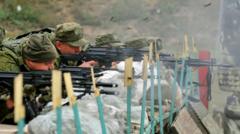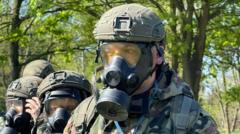**A closer look at the record-breaking fatalities among Russian troops in the Ukraine conflict, including personal stories of soldiers and their families.**
**Staggering Losses: Russia Suffers Heavy Casualties in Ukraine Conflict**

**Staggering Losses: Russia Suffers Heavy Casualties in Ukraine Conflict**
**New Data Reveals Russian Military's High Death Toll Amid Ongoing War**
In a worrying escalation of the ongoing war in Ukraine, 2024 has marked the deadliest year for Russian forces since the conflict's inception, witnessing at least 45,287 military fatalities. This figure represents a staggering increase—nearly threefold—compared to the first year of the invasion and surpassing the losses recorded in 2023, a year marked by the protracted and brutal battles in Bakhmut.
As the Russian front lines inch forward, the death toll has risen sharply each month, with estimates now indicating that Russia has lost a grim average of 27 soldiers for every kilometer of Ukrainian territory captured. The BBC Russian Service, in collaboration with independent media organization Mediazona and a volunteer research team, has meticulously collated data from cemeteries, military memorials, and obituaries, identifying the names of 106,745 Russian soldiers fallen during the full-scale invasion. However, military analysts suggest the real death toll may be significantly higher, above 164,000, based on their estimates covering between 45% to 65% of fatalities.
Tragically, February 20, 2024, emerged as the bloodiest day for Russian forces, with a missile strike on a training ground near Volnovakha, which resulted in the deaths of 201 servicemen, including young soldiers Aldar Bairov and Okhunjon Rustamov. Both men had been mobilized from civilian life, their families now enduring the grim reality of repeated loss due to the war. The stark choice for soldiers, many of whom volunteered or were drafted, has led to a rapid turnover in personnel, yet soldiers' training remains limited, with many deployed to the front lines after only brief preparation.
The complexity of Russian casualty counts highlights the challenges in accurately assessing losses. Recent reports indicate a systemic rise in volunteer soldiers, many of them incentivized by significant pay. Yet, expert analysis suggests that the high casualty rates among these poorly trained volunteers exacerbate the challenges facing Russian military leadership.
Overall, 2024 paints a stark picture of warfare: as Russian forces captured a total of 4,168 square kilometers, the staggering human cost of this territorial gain is underscored by increasingly emphasized tactics that prioritize sheer numbers over effective combat training. The true toll of this conflict raises critical questions about the long-term implications for Russia's military capability and the sustainability of its war efforts.
As the Russian front lines inch forward, the death toll has risen sharply each month, with estimates now indicating that Russia has lost a grim average of 27 soldiers for every kilometer of Ukrainian territory captured. The BBC Russian Service, in collaboration with independent media organization Mediazona and a volunteer research team, has meticulously collated data from cemeteries, military memorials, and obituaries, identifying the names of 106,745 Russian soldiers fallen during the full-scale invasion. However, military analysts suggest the real death toll may be significantly higher, above 164,000, based on their estimates covering between 45% to 65% of fatalities.
Tragically, February 20, 2024, emerged as the bloodiest day for Russian forces, with a missile strike on a training ground near Volnovakha, which resulted in the deaths of 201 servicemen, including young soldiers Aldar Bairov and Okhunjon Rustamov. Both men had been mobilized from civilian life, their families now enduring the grim reality of repeated loss due to the war. The stark choice for soldiers, many of whom volunteered or were drafted, has led to a rapid turnover in personnel, yet soldiers' training remains limited, with many deployed to the front lines after only brief preparation.
The complexity of Russian casualty counts highlights the challenges in accurately assessing losses. Recent reports indicate a systemic rise in volunteer soldiers, many of them incentivized by significant pay. Yet, expert analysis suggests that the high casualty rates among these poorly trained volunteers exacerbate the challenges facing Russian military leadership.
Overall, 2024 paints a stark picture of warfare: as Russian forces captured a total of 4,168 square kilometers, the staggering human cost of this territorial gain is underscored by increasingly emphasized tactics that prioritize sheer numbers over effective combat training. The true toll of this conflict raises critical questions about the long-term implications for Russia's military capability and the sustainability of its war efforts.




















